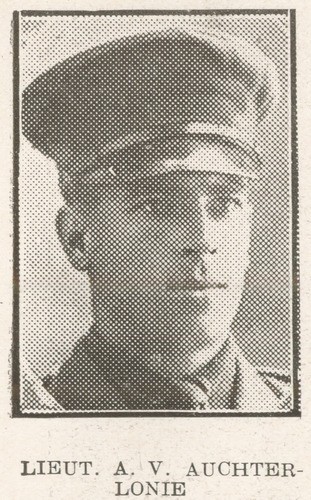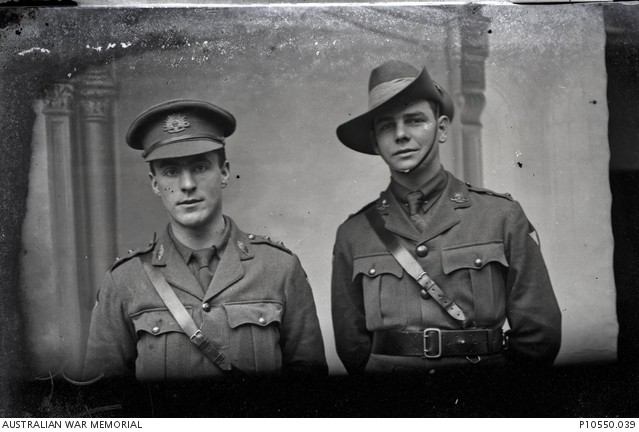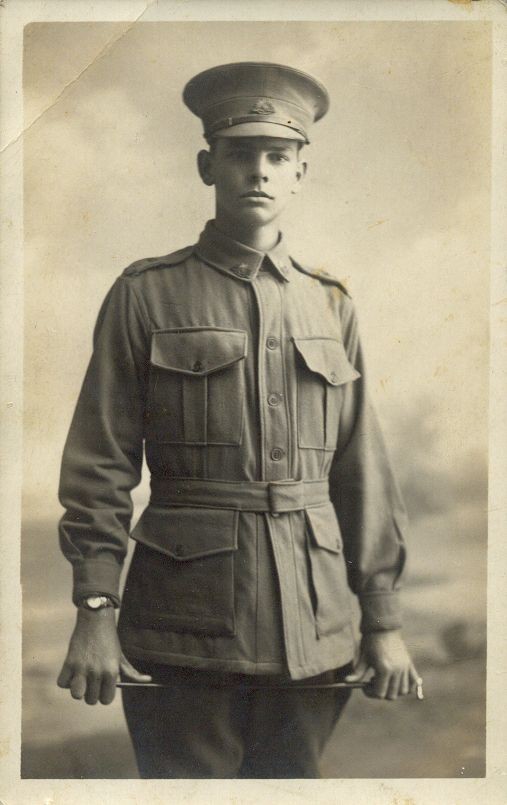Auchterlonie Brothers of Gympie Identified in a World War I Photograph
By JOL Admin | 24 September 2015

John Oxley Library, negative number 130187
One of the wonderful outcomes of the Distant Lines World War I exhibition at the State Library has been the opportunity for families to identify previously unknown soldiers appearing in photographs from our collection.
This photograph, which appears as part of a photographic collage in the Talbot Family Treasures Wall on Level 4, is one such instance. This image was donated to the library in the late 1990s as part of a larger collection relating to the Dath Family (Accession no. 6033, D3-2-96). At the time the donor did not know the identities of the two soldiers, apart from the fact that they were at the Enoggera training camp in Brisbane prior to their embarkation for the front. The original photograph was captioned "Taken at Enoggera Camp before Vivien and Cecil sailed for the war - all leave stopped. Mother, self and Agnes in front".
Luckily for us the donor spotted the photograph whilst viewing the exhibition and was able to update us with some recently discovered information which tells a moving and tragic story about the two young men.
The people in the photograph were identified as (standing left to right) Mary Jane McMaster (Aunt Ja), Lieutenant Archibald Vivian Auchterlonie, his brother Cecil Arthur Auchterlonie and Elsie Dath. Seated far left is Agnes Dath and seated far right is Nellie Dath. Elsie, Agnes and Nellie Dath were sisters. When their mother died in 1907 their Aunt Ja stepped up to look after them.
Both soldiers, Vivien (left) and Cecil (right) were the sons of Archibald Auchterlonie and Elizabeth Auchterlonie (nee Toms) of Gympie. The couple had nine children - five sons and four daughters. Three sons, Archibald, Cecil and Bertrand, were killed during the First World War. Another son, Robert George, born in 1886, died as an infant. Their only surviving son, Roy, was born in 1900 and was therefore too young to enlist.

Left to right: Bertrand, Vivian and Cecil Auchterlonie. Discovering Anzacs Website: http://discoveringanzacs.naa.gov.au/browse/gallery/28550
Lieutenant Archibald Vivian Auchterlonie, known as Vivian, of the 25th Australian Infantry Battalion was a telephonist working at the Gympie Telegraph Office. He enlisted on the 18th June 1915 and embarked from Brisbane on the HMAT Aeneas on 29th June of that year. The photograph was taken shortly before the brothers left for the front, possibly on the 28th June. Vivian served at Gallipoli where he was killed in action on 20th October 1915 from a gunshot wound to the head. He was only 23 at the time of his death.

Lieutenant Archibald Vivian Auchterlonie, Queenslander, 11 December 1915.
Lieutenant Cecil Arthur Auchterlonie, also of the 25th Battalion, enlisted on the 13th May 1915 at the age of 19. His occupation before the war was as a clerk with the Union Bank of Australia in Gympie. He embarked with his brother, Archibald, on the Aeneas and served at Gallipoli and on the Western Front. He fell ill in Gallipoli, suffering from enteric fever, in November 1915, and was sent to Mudros on the Greek island of Lemnos to recover. He re-joined his unit in France in March 1916 when he was promoted to sergeant. Cecil was wounded in action in France on the 5th August 1916, suffering shrapnel wounds to both legs and his left arm. After recuperating in England he returned to France in December 1916 where he was promoted to 2nd Lieutenant.

Lieut. Herbert Crowther Foxton (left) and 2nd Lieut. Cecil Arthur Auchterlonie, France, ca. 1916. Australian War Memorial, P 10550.039
In January 1917 he was promoted to Lieutenant and in April of that year he was seconded and posted for duty to the 7th Training Battalion in Rollestone, England, on the Salisbury Plain. Cecil requested a transfer back to the front and returned to France in June 1918 where he re-joined the 25th Battalion. On the 4th July he was involved in an attack on the enemy trenches north east of Villers Bretonneux for which he received the Military Cross. The recommendation for this honour is below:
"During the operations North East of Villers Bretonneux on the morning of the 4th July 1918, he displayed conspicuous gallantry and devotion to duty. He was the first to enter the enemy front line. He disposed of two Germans with his revolver and then organised clearing parties to either flank. Later when the Company on his right had been forced to withdraw from heavy casualties and enemy pressure, he sent forward a platoon to recapture and hold the position. It was on account of his initiative and dash that the position was rewon and held." C. Rosenthal, Major-General Commanding Second Australian Division.
In a later offensive, also near Villers Bretonneux, on the 17th July, he was awarded a bar to add to his Military Cross, when he took charge of his company after the commanding officer was killed. He led the men in an attack on the enemy line. When it was known that the Germans were massing for a counter-attack he went forward to the enemy lines gaining vital information about German numbers and positions, before attacking with Lewis and Vickers guns. It was noted that "All through the operation this officer showed a wonderful example of coolness and courage".
Sadly Cecil was killed in action about 10 miles from Villers Bretonneux, on the 10th August 1918 at the age of 22. An eyewitness recounted "During the afternoon of the 9/8/18 the Battalion had advanced some distance and established a line. In the morning about 1 a.m. on the 10th August Lieutenant Auchterlonie went out to try and get in touch with the unit on our right who were some distance away. While doing this he was killed instantaneously by machine gun bullet to the head. He was recovered by his brother officers and buried".

Cecil Arthur Auchterlonie. Image from Discovering Anzacs Website, http://discoveringanzacs.naa.gov.au/browse/gallery/39135
The other Auchterlonie brother to die during the war was Sergeant Bertrand Innes of the 15th Battalion. Bertrand enlisted in Gympie on the 22 January 1915 and travelled to Egypt on the Star of England. After training in Egypt he joined his battalion at Gallipoli on the 2nd June 1915. On the 8th August of that year he was posted as wounded and missing. An enquiry held at Serapeum, Egypt, on the 28th April 1916 found that it was reasonable to suppose that he had been killed in action on the 8th August 1915. He was 21 at the time of his death.

A family letter regarding Bertram's death is held by the Australian National Archives in their World War I Service Records. It was written by Elizabeth Loosemore of Gympie, a cousin of the Auchterlonie boys, on the 16th November 1915, to her Aunt Rachel Luxford. The following is an extract:
"Viv was speaking to the Major of the 15th Battalion & he told him that the last he saw of Bert was when he led his platoon in a charge & he never returned. Bert was recognised as an officer & loved & respected by all & both Viv & Fred said that if Bert had lived he would have received his commission. They were also speaking to a sergeant who was in the same engagement & he said that he saw Bert fall, shot in the head. They don't think that it is possible that Bert is alive & a prisoner of war, as there was no chance of them getting out to rescue dead or wounded....Poor auntie is terribly broken up again, & it would touch a heart of stone to see her struggling to be brave for the sake of her children."
It is amazing how one photograph can tell such a rich and poignant tale, bearing testimony to the sacrifices made by so many families during this terrible conflict. We are very grateful to the donor for providing the clue which unlocked the story behind this image.
Lynn Meyers, QANZAC 100 Content Curator.
.
Comments
Your email address will not be published.
We welcome relevant, respectful comments.